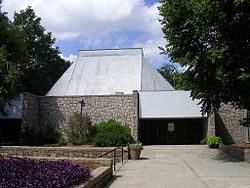Fernbank Science Center
 |
|
| Established | 1967 |
|---|---|
| Location | 156 Heaton Park Drive NE Atlanta United States |
| Coordinates | 33°46′43″N 84°19′05″W / 33.77855°N 84.318089°W |
| Type | Science museum |
| Director | Douglas Hrabe |
| Owner | DeKalb County School System |
| Website | Fernbank Science Center |
The Fernbank Science Center is a museum, classroom, and woodland complex located in Atlanta. It is owned and operated by the DeKalb County School System, which announced in May 2012 it was considering closing the facility to cut its annual budget, then quickly shelved the plan after public outcry. The nearby Fernbank Museum of Natural History is a private non-profit organization that is separate from the Science Center.
The Fernbank Science Center opened in December 1967, and is an educational facility and an integral part of the DeKalb County School System. It provides programs for the science education of local students, pre-K-12. Both its planetarium and observatory are open for public shows on specific occasions.
The mission of the Science Center is to provide and promote an understanding of science and technology and to communicate to its visitors the harmony and order of the natural world. Fernbank contains many materials for instruction, including dinosaur skeletons, rocks and minerals, a collection of tektites, an Aeronautics Education Laboratory and an electron microscope lab. The center also has an authentic Apollo spacecraft from the unmanned Apollo 6 Saturn V test flight, and is home to a planetarium with a 70-foot (21 m)-diameter projection dome.
The Jim Cherry Memorial Planetarium is a 500-seat celestial theater in the round, equipped with a 70-foot (21 m), a Mark V Zeiss star projector, and over 100 special effects projectors. The planetarium, which was built in the 1967's is the largest planetarium within the state of Georgia and one of the largest in the U.S. It was also the first planetarium to be owned and operated by a public school system in the United States of America.
In 2012 Fernbank Science Center was the recipient of a grant from Lockheed Martin which was used to refurbish the Jim Cherry Memorial Planetarium, and give the theater a technological upgrade bringing it into the 21st century and the digital age. A major component of technological upgrade is the fulldome/immersive projection system, produced by e-Planetarium of Houston. The fulldome system is intended to complement the planetarium's iconic Zeiss star projector not replace it.
...
Wikipedia

